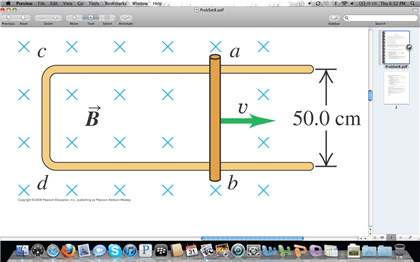PHYS 012A Lecture Notes - Lecture 16: Direct Current, Electromotive Force, The Terminal

Chapter 28: Direct Current Circuits (constant current)
Circuit Analysis
- Kirhhoff’s Rules a e used for aalsis.
o Rules based on conservation of energy and conservation of electric charge for isolated
systems
- Circuits may involve direct current or alternating current.
Direct Current
- When the current in a circuit has a constant direction, the current is called direct current.
o Most of the circuits analyzed will be assumed to be in steady state, with constant
magnitude and direction.
- Because the potential difference between the terminals of a battery is constant, the battery
produces direct current and the battery is known as a source of emf.
Electromotive Force
- The electromotive force (emf), , of a battery is the maximum possible voltage that the battery
can provide between its terminals.
o The emf supplies energy, it does not apply a force.
- The battery will normally be the source of energy in the circuit.
- The positive terminal of the battery is at a higher potential than the negative terminal.
- We consider the wires to have no resistance.
Internal Battery Resistance
Process:
At A: no potential
Over A and B: potential increases to epsilon
From B to C: potential stays the same
From C to D: some voltage (potential) is lost = Ir
At D: potential is epsilon minus Ir
From D to E: potential stays the same
From E to F: potential drops to 0
Process restarts
find more resources at oneclass.com
find more resources at oneclass.com

Load Resistance
- The terminal voltage also equals the voltage across the external resistance.
o This external resistor is called the load resistance.
o In the previous circuit, the load resistance is just the external resistor.
o In general, the load resistance could be any electrical device.
▪ These resistances represent loads on the battery since it supplies the energy to
operate the device containing the resistance.
Power
- The total power output of the battery is
P = I ΔV = I ε
- This power is delivered to the external resistor (I 2 R) and to the internal resistor (I2 r).
P = I2 R + I2 r
- The battery is a supply of constant emf.
o The battery does not supply a constant current since the current depends on the
resistance AND the battery does not supply a constant terminal voltage.
Resistors in Series
- When two or more resistors are connected end-to-end, they
are said to be in series.
- For a series combination of resistors, the currents are the
same in all the resistors. I = I1 = I2
- The potential difference will divide among the resistors such
that the sum of the potential differences across the resistors
is equal to the total potential difference across the
combination.
- Potentials add
o ΔV = V1 + V2 = IR1 + IR2 = I (R1+R2)
o Req = R1+R2
o Consequence of Conservation of Energy
- The equivalent resistance has the same effect on the circuit as
the original combination of resistors.
o Req = R1 + R2 + R3 + …
▪ The equivalent resistance of a series combination of resistors is always greater
than any individual resistance.
- If one device in the series circuit creates an open circuit, all devices are inoperative.
find more resources at oneclass.com
find more resources at oneclass.com

Resistors in Parallel
- The potential difference across each resistor is the same because each is connected directly
across the battery terminals.
ΔV = ΔV1 = ΔV2
- A junction is a point where the current can split.
- The current, I, that enters junction must be equal to the total current leaving that junction.
o I = I 1 + I 2 = (ΔV1 / R1) + (ΔV2 / R2)
o The currents are generally not the same.
o Consequence of conservation of electric charge.
- In parallel, each device operates independently of the others so that if one is switched off, the
others remain on.
- The current takes all the paths.
o The lower resistance will have higher currents.
o Even very high resistances will have some currents.
- The inverse of the equivalent resistance of two or more resistors connected in parallel is the
algebraic sum of the inverses of the individual resistance.
o The equivalent is always less than the smallest resistor in the group
Combinations of Resistors
- The 8.0-W and 4.0-W resistors are in series and can be
replaced with their equivalent, 12.0 W.
- The 6.0-W and 3.0-W resistors are in parallel and can be
replaced with their equivalent, 2.0 W.
- These equivalent resistances are in series and can be
replaced with their equivalent resistance, 14.0 W.
1 2 3
1 1 1 1
eq
R R R R
= + + +
find more resources at oneclass.com
find more resources at oneclass.com
Document Summary
Kir(cid:272)hhoff"s rules (cid:272)a(cid:374) (cid:271)e used for a(cid:374)al(cid:455)sis: rules based on conservation of energy and conservation of electric charge for isolated systems. Circuits may involve direct current or alternating current. When the current in a circuit has a constant direction, the current is called direct current: most of the circuits analyzed will be assumed to be in steady state, with constant magnitude and direction. Because the potential difference between the terminals of a battery is constant, the battery produces direct current and the battery is known as a source of emf. The electromotive force (emf), , of a battery is the maximum possible voltage that the battery can provide between its terminals: the emf supplies energy, it does not apply a force. The battery will normally be the source of energy in the circuit. The positive terminal of the battery is at a higher potential than the negative terminal. We consider the wires to have no resistance.



